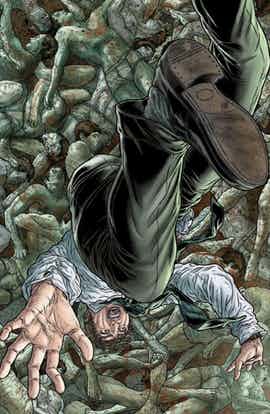
“Clone” #3 by David Schuler and Juan Jose Ryp picks up directly after last issue’s cliffhanger, as Patrick leads Luke into the enemy’s lab complex.
The opening scene has some excellent shock value due to Ryp’s lurid visuals. Also, the villainous Patrick is a great character. He is made of the same genetic stuff as Luke and the other clones, yet out of numerous clones, only Patrick seems to have chosen to ally himself with what the others see as the enemy. Patrick is shrewd yet nearly deranged, seeing the other clones are threats rather than kin. He is unable to separate his identity from genetics, unable to feel legitimate unless he is unique. Thus Schulner brings up the question almost every clone story has to answer: are clones human, each and every copy? Or are they only variations of the same person?
Afterwards, Schulner’s plotting takes some conventional turns. The rescue of the pregnant wife still feels a little cliched despite the twist about the singularity of the child. The narrative also expands to include imprisonment, interrogation, mistaken identity and a ticking clock for the rescue. All these elements are competently introduced, but they’re all old-hat and feel right out of a typical action movie. There’s even the well-worn trope of a pensive shower scene.
Schulner’s political framing plot is meant to add depth, but the politicians and their families come off more as plot devices than people, especially Vice President Charles’ daughter. However, the ending line and scene are resonant because Schulner cleverly ties together the themes of parenthood and of cloning, and how both are heavily linked to his central theme of identity. Where clones excite disgust and questioning of selfhood from Patrick, children are cherished and protected. By contrasting these two treatments of genetic propagation, Schulner reinforces Luke’s quest driven by love and sacrifice instead of vanity and self-promotion. When parents see themselves in children, is that so different from a clone’s face staring back like a mirror’s reflection?
Ryp’s artwork continues to work well for the story in “Clone” #3.
It’s difficult to draw a realistic range of different faces and bodies, but it’s also impressive for an artist to be able render the same features, recognizably and consistently, from different angles, over and over, sometimes within the same scene. Schulner’s script and Ryp’s artwork keep which is which very clear for the readers, and yet the clones are clearly identical physically. Ryp still draws environments and people alike in a super-wrinkly style, where every surface looks like pruney hands after a long bath, but I’m starting to enjoy it as a stylistic quirk.
Felix Serrano’s colors are cool and translucent in the lab scenes and warm and light in “real world” scenes, emphasizing the contrast between artificial and natural.
“Clone” #3 continues on genre-tested lines, but the dialogue, pacing and artwork are well-executed, and I’m interested in how Schulner will further develop Luke, Patrick and the other clones in combination with the themes of identity and kinship.

